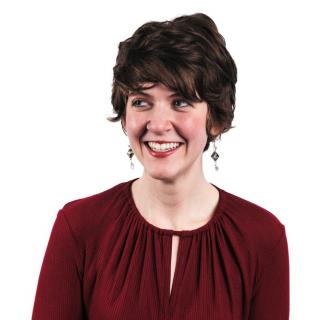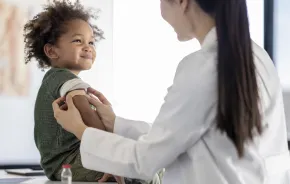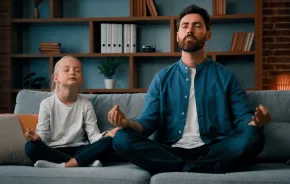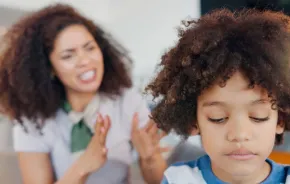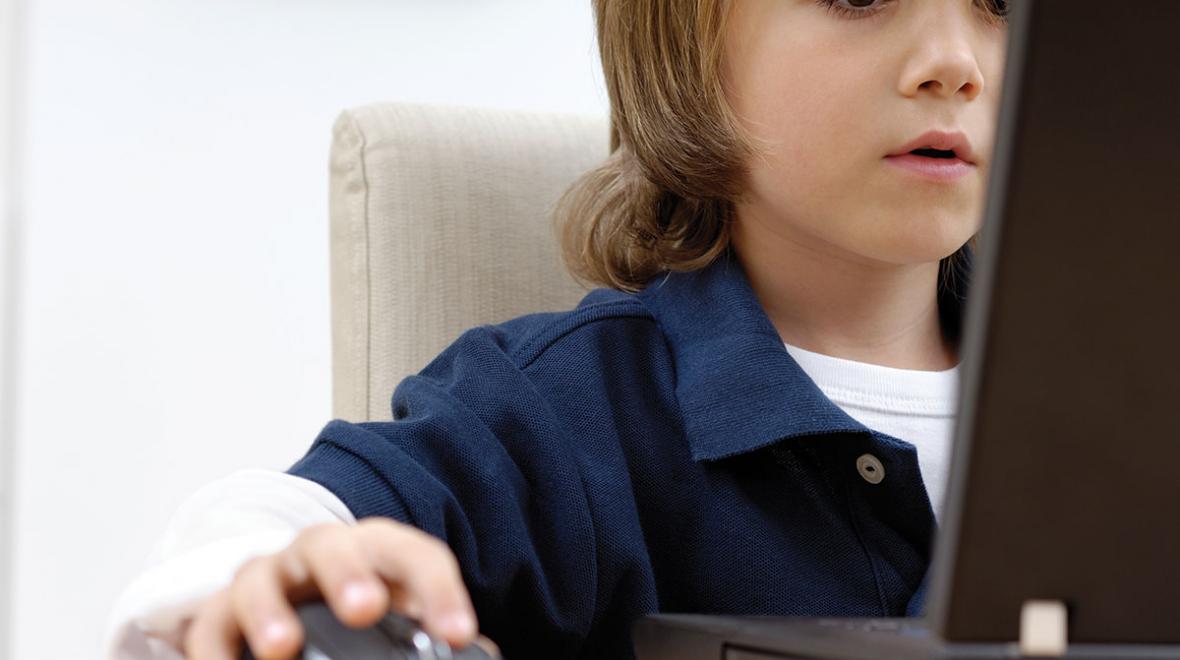
Mary* was 8 the first time she saw porn. She was on her mom’s iPad, as she so often was, and Googled a word she’d overheard or hit a link she wasn’t supposed to or clicked an ad she didn’t understand. Whatever the case, she found herself watching people do things she had never, ever seen before.
So she went back. Each time was accompanied by the thoughts: This makes me feel different. This makes me feel weird. I shouldn’t be watching this, but . . .
“It’s like picking a scab,” says Amy Lang, a Seattle-based sexuality educator who runs Birds + Bees + Kids. Lang is one of the few professionals to whom parents can turn when they learn their child did what Mary did: stumbled upon online pornography.
Oh no, you might be thinking. Not my kid. He’s not interested. She would never.
Don’t kid yourself, says Lang. Nearly half of online users ages 10–17 had seen porn (two-thirds of whom had done so on accident), according to one study by the University of New Hampshire (UNH). The numbers were even higher in another UNH study: 93 percent of boys and 62 percent of girls said they saw online porn sometime during their adolescence.
The average age of exposure, experts say? Nine years old.
This ain’t your old-school Playboy
Porn today means something very different than the porn of even five or 10 years ago, let alone decades back. It is predominantly amateur (whether produced to look that way by porn studios or actually so). It is also highly convenient; a 2010 American Psychological Association (APA) report estimates 12 percent of all websites are pornography sites, and a quarter of all search-engine requests are for pornography.
“Before, we had to work to find it,” Lang says. “Our kids don’t.”
What they find, whether accidentally or purposely, isn’t your friend’s older brother’s crumpled Playboy, either. “These are graphic, moving, [high-definition] images,” says sex educator and therapist Jo Langford. “Those are pretty desensitizing and kind of scary.”
They also present a portrayal of sex often stripped of such necessary elements as intimacy, mutual pleasure and tenderness, to say nothing of lacking variations in body type or sexual orientation.
“Porn gives our kids a script,” Lang explains. “Kids think they know how to do sex because they’ve seen sex.” That’s bad, because porn isn’t sex, it’s sexual, says Langford. Adults can typically tell the difference between the two, but kids often can’t.
That disconnect can lead to any number of issues, including concerns about body image.
11 resources for when your kid sees porn
In this follow-up article, Jo Langford and Amy Lang share advice for helping kids safely explore sexuality.
“Nobody knows anymore what an average human penis is supposed to look like,” Langford says. Plus, there’s this thing about pubic hair. “Kids never see anyone with pubic hair anymore,” Langford says. If kids or teens themselves do have hair, despite it being normal, “they feel dirty and unkempt.”
Even a kid’s concept of masturbation can be warped: “I’ve literally had kids say to me, ‘You can’t masturbate without looking at porn,’” Langford says.
Is this because the kids in question, after seeing porn, need more explicit visual stimulation to become aroused? Like so much of scientific research, it depends on whom you ask, but recent studies suggest viewing porn as an adolescent can have long-term impacts on many aspects of a person’s sexuality, sex life and relationships.
“After 40 years of peer-reviewed research, scholars can say with confidence that porn is an industrial product that shapes how we think about gender, sexuality, relationships, intimacy, sexual violence and gender equality — for the worse,” wrote Gail Dines, professor of sociology at Wheelock College in Boston, for The Washington Post in April.
Dines cites one 2011 study that found that 83 percent of surveyed college men in the fraternity system at a Midwestern public university reported seeing mainstream pornography and that those who did were more likely to commit rape or sexual assault — as long as they wouldn’t get caught.
Another study, this one conducted in 2013 by the Center for Innovative Public Health Research, found that 14- to 21-year-old perpetrators of sexual violence were more likely to have watched violent pornography. Note the use of the word “violent,” says Michelle Ybarra, president of the Center for Innovative Public Health Research. “Not all pornography is the same,” she told Newsweek in May.
Unfortunately, chances are good the violent kind is the kind children find. “They’re not going to Google ‘I want feminist porn. I want my porn with a storyline. I want safe, healthy pornography,’” Lang says.
That lack of storyline, adds Langford, is one of the most unsettling aspects of kids being exposed to porn. “There’s literally nothing left to the imagination,” he says. “That bothers me, because you need imagination to have empathy and [you need empathy] to develop relationships with other people.”
The influence of porn on sexuality is well-documented; perhaps you’ve heard the term “fifth base” in relation to the increase in straight young women trying anal sex at their male partners’ insistence — or sometimes, coercion — rather than their own interest.
Also often reported are concerns about girls growing up in a hypersexualized world as influenced by hardcore porn. As the 2010 APA report found, “There is evidence that girls exposed to sexualizing and objectifying media are more likely to experience body dissatisfaction, depression and lower self-esteem.”
But this isn’t just about teen boys demanding certain sexual acts, and it’s not just about how girls identify and develop into women. This is also about how all kids of all genders and, perhaps most critically, all ages are using the Internet, and in doing so, often finding porn. The problem: Pubescent and — as the statistics show is extremely common — prepubescent — children are developing their sexual selves out of a very narrow, very shallow pool of information, often to the severe detriment of themselves and their future partners.
And there’s only one sure fix: You.
“Your children will see porn no matter what. Period. End of sentence,” Lang says. “It’s not their job to avoid it. It’s your job to make sure they have healthy sexual education.”
Back to basics
That means books (It’s So Amazing! is Lang’s go-to, while Langford has written two books on the subject). That means early prevention (Langford recommends conversations about porn start as early as 7, if not earlier). And, most importantly, that means talking.
“[My daughter] could not have a parent who could be more comfortable with the sex talk,” says Josephine*. But this mom figured she should wait to talk about sex until her daughter showed an interest in the topic. “But [kids] don’t need to do that anymore.”
Instead, when she got curious, Josephine’s daughter, Alice*, did what we all do: She Googled. They had parental controls set on the computer, Josephine says. “She’s just smarter than I am at those things.”
Alice was 9 the first time Josephine realized she was looking at porn regularly. She told her to stop, that this was not kids’ stuff. It didn’t work. “We’re asking them to not do something they don’t have the skills to not do yet,” she says.
So she and her husband cracked down. No computer in Alice’s room. No smartphone. No access to digital porn — or so Josephine thought. Then one day when Alice was 12, Josephine picked up Alice’s Kindle, a Christmas gift that she figured, with its lack of high-speed Internet, would be safe. On it: a pornographic comic.
You don’t want to be the parent who gets the phone call from the other parent who says, ‘Your child showed my child pornography on their phone today.’
Josephine was at a loss. “No matter what I do,” she told Alice, “you’re going to dig deeper and deeper [to find porn].” And that, she said, was the last thing she wanted, to run the risk of her daughter being forced to go “so far underground” that she found even more adult content. “I knew I could not control her, and the harder I tried, the sneakier she got,” Josephine says. So Josephine decided to stop trying to police Alice’s usage and told her daughter as much.
“I let her know that I was worried about what [porn] was teaching her about sex and relationships, but that it was clear I couldn’t control or protect her from it,” she says. “I also told her that I was always there to answer questions or help if she needed it; I wanted her to know that she could always come to me if she was in trouble. Just to be clear, it did not stop my concern. I just didn’t want her going deeper underground with it.”
First, however, Josephine insisted they sit down together and go frame by frame through the comic. “Education,” she says, “has been my go-to in situations like this.”
It took a week for Josephine to calm down enough to follow through on her plan but the resulting conversation — with Josephine asking Alice to explain what was happening in each scene, who was and wasn’t having fun and what each scene meant in terms of respect — was, she says, one of “my hardest, proudest parenting moments.” The exercise, as uncomfortable as it was for both Alice and Josephine, helped Josephine better understand her daughter. She doesn’t know if it influenced her daughter’s porn consumption, but it helped her teach Alice that healthy use of porn should include a framework for consent and reciprocal pleasure.
“It made a difference to me to know that I’d gotten the message of our [family’s] values through,” Josephine says. “That was really important.”
The birds and the bees — rebooted
Josephine, whose daughter is now 17 and doesn’t watch porn as much as she used to (“It seems so fake,” she says), doesn’t often discuss her experience with other parents. Like all the parents in this story, she’s worried about the harm doing so may inflict on her child’s reputation even though they know their kids aren’t alone. “I know my kid is not the only one,” says Lydia*, mom of 9-year-old Mary. But it sure can seem that way.
“I felt so alone because you can’t just Google ‘expert in pornography exposure for children’ and find a professional who can help you with that,” Lydia says. “I had to make a lot of calls and tell my story to a lot of random people on the phone so I could get to the right person.”
The usual parachute cords parents pull when they come up against a difficult problem — talking to their own parents, going to a parenting group, chatting with the neighbor mom — don’t exist here. Porn kills the village, or rather, our own hang-up about talking about porn kills the village. Either way, by not talking about the reality of porn and the high likelihood our children will encounter it, we put our children at greater risk for exposure and risk having a negative impact on their healthy sexual development.
That has to stop.
“Talking about porn needs to become part of the assessment in your well-child checks,” Lydia says. “This needs to be part of the care of our children now.”
Or, as Lang puts it: “You don’t want to be the parent who gets the phone call from the other parent who says, ‘Your child showed my child pornography on their phone today.’ You do not want to be the parent who gets the phone call from the school reporting, ‘Your kid did this and exposed some kid to pornography today on the school bus.’ You don’t want to be that parent.”
That one click
Several years later and Mary is still working through much of what she witnessed during the year, perhaps longer, that she watched porn.
“I think, in her situation, it was almost a trauma,” Lydia says. “Some of the things that I think she saw, she was not emotionally, physically or cognitively prepared for. … I guess I was in denial that just one click can expose your child to some of the most horrific things you could imagine.”
Lydia blames herself. “I’m ashamed that I let it happen,” she says. “I feel terrible.”
But, she’s quick to add, letting those feelings stop her from helping her child would be the real defeat.
“Don’t let your own shame or feelings that you failed somehow, or that something is wrong with your child because they looked at this stuff, stop you from reaching out, because it’s important,” she says. “We can’t let this just infuse into our children’s understandings of themselves. We can’t just think it’s normal and OK.”
*Names changed for privacy
5 points to make during ‘the porn talk’
|




